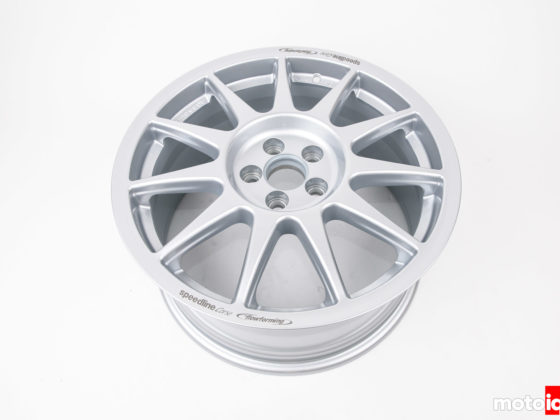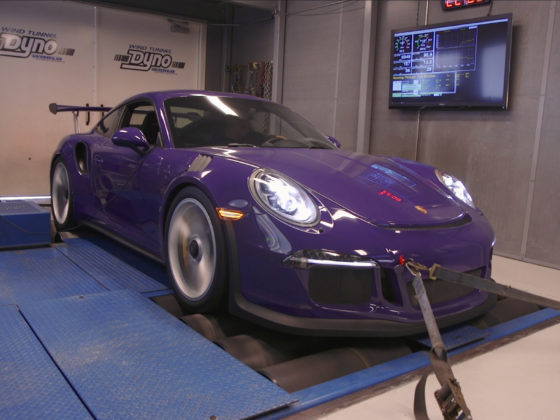
The wastegate port of the turbine housing is only in the big flow port as you’d never have to wastegate at the low engine speeds where the flapper valve would be closed. The turbine housing has a nice feature which is a cast-in divider wall separating the flow going to the wastegate port and the volute. So, that should keep the flow going to the volute more uniform.

Everything mounted together.

The other bit of technology used in the 2019 CX-5 is updated G-Vectoring Plus. The first generation of G-Vectoring used clever engine braking to create an imperceptible weight transfer to the front tires to create immediate and consistent turn-in. G-Vectoring Plus adds a slight dragging of the outside front brake to aid corner turn-out. Mazda initially tried using the throttle but found out through testing that people could feel the throttle being applied which was disruptive. There’s that ‘feel’ thing again. In the lane change test above, the left is without GVC+ and the right with GCV+. As it turns out, us humans are a bit slow to react and then we tend to over-correct. Hence, we get a bit out of shape in a quick lane-change maneuver. This is my take on the situation: in a typical lane change maneuver, you turn the wheel, the loads first squish the tire sidewalls and then shift all the slop in all the suspension joints before the car actually starts to change direction. But the human brain has already noticed the lack of turn-in response to the initial turning of the wheel and therefore commands additional steering angle. And then the car starts turning too much and we start to correct and the car gets bent all out of shape. Humans are often a poorly damped system; those of you who have taken controls systems know what I mean. With GVC+, as soon as the system detects the initial steering wheel turn-in, it engine brakes ever so slightly to speed-up the loading of the front tires reducing the delay time from driver input to the vehicle reacting. Hence, GVC+ makes the handling more predictable and consistent. I saw this exact lane change maneuver play out next to me on the morning commute to work one day on the 405 highway in Los Angeles. A lady in a Ford Escape was not paying attention and noticed at the last second the car in front of her was coming to a stop. She attempted a quick lane-change and got all bent out of shape. She over-corrected three times before the car finally flipped over on its side. Fortunately, she managed not to hit anyone, but she did back up traffic on the 405 for about 100,000 very unhappy people.

Mazda has gone all fancy on their 2019 interiors to compete with the luxury brands. Note the display screen has been moved from a lower center console position to higher-up and further away. This was intentional. The screen only functions as a touchscreen when the car is stationary. When the car is in motion, the control knob must be used. The screen was pushed further away to prevent people from trying to touch it. During observational VOC of people trying to use a touchscreen while driving, Mazda observed that it distracted people too much by taking their eyes off the road for too long. Dave had a prime example where a test subject was driving down the 405 while trying to use a touchscreen and the car went thump-thump. The driver was like, “what was that?” Dave said, “that was a lawn chair you just drove over”. Not so different than the lady who flipped her Ford Escape onto its side. The new Mazdas are now Apple Carplay and Andriod compatible and Mazda observed it took about three weeks of use to become proficient in using the control knob and users actually preferred using it over a touch screen once accustomed. In my wife’s car, I didn’t even know the screen was a touch screen for over a year and I still don’t ever touch it. Who wants fingerprints on it anyway.




7 comments
The driving force graph makes no sense.
F=ma
Not F=m
Probably marketing person just mislabeling what should be kgf. Which I need to fix myself… will edit. Thanks for the catch.
Looking at the graph a little more closely now, looks like about 75kgf to maintain speed and 325kgf to have desired acceleration. So 250kgf is about 2450N going towards acceleration and a vehicle mass of 1750kg. Works out to about 1.4 m/s^2. 1.4 m/s = 3.13mph. So…. increase almost 10mph in 3 seconds. Seems like a reasonable acceleration rate for this passing scenario.
Thanks for the clarification.
Why Mazda didn’t take full advantage of their ‘dyanamic pressure turbo’ system by squeezing out more top end power without sacrificing low end torque and causing turbo lag?
They would have to go to a bigger turbo to get more power on the top-end. That would not allow them to meet their torque target at 2000rpm where they are focused on driveability because that’s where their users spend like 97% of their time.
Ok I see, I just wish they have a more performance orientated option as well.
Does the low end and mid range performance feel more like a big, torquey naturally aspirated engine than a typical turbocharged engine?
Funny thing about that stability control: I noticed that my 2018 Mazda MX-5 GT will quite happily do donuts, which isn’t quite possible with an open differential. Sure enough, the tail end only whips out once a light on the dashboard starts blinking: the ABS is transferring the torque to the opposite wheel, even though stability control is off, in order to facilitate irresponsible driving.
Also, since I couldn’t find it on paper anywhere: the headlamps turn to see around corners, though mine inexplicably lacks the levelling system.